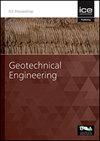干燥空气技术稳定弱沉积物
IF 1.7
4区 工程技术
Q3 ENGINEERING, GEOLOGICAL
Proceedings of the Institution of Civil Engineers-Geotechnical Engineering
Pub Date : 2022-08-03
DOI:10.1680/jgeen.21.00231
引用次数: 0
摘要
许多现有的地面改善技术是有效的,但涉及大量的二氧化碳排放。因此,任何绿地改良技术都是有益的。在这项工作中,在低压和相对湿度下供应的干燥空气被用来从软土沉积物中除去水分。调查采用模型比例尺,在尺寸为1.0 × 1.0 × 0.75 m的箱体内形成软土层。土床上装有细颗粒柱,用于注入干燥空气。该技术是真空固结的反向过程,其中可以应用于土壤的负孔隙水压力的大小是有限的,因此需要仔细的施工程序。干空气方法简单,不需要任何复杂的施工程序。在有限时间内进行的调查显示,土床的强度有了显著改善,表明可能全面实施。该技术的全面实施可能不需要任何新的施工方法,因为其过程与真空固结非常相似。然而,地面条件的变化,包括地下水位,可能会带来额外的挑战,补充信息(土壤-水特征数据和数值模拟)可能是全面实施这一技术所必需的。本文章由计算机程序翻译,如有差异,请以英文原文为准。
Dry-air technology for stabilising weak deposits
Many available ground improvement techniques are effective, but involve large amounts of carbon dioxide emissions. Any green ground improvement technique would thus be beneficial. In this work, dry air, supplied at low pressure and relative humidity, was used to remove water from a soft soil deposit. The investigation was carried out at model scale, with a soft soil layer formed in a box of size 1.0 × 1.0 × 0.75 m. The soil bed was fitted with slender granular columns for the injection of dry air. The technique is the reverse process of vacuum consolidation, in which the magnitude of negative pore water pressure that can be applied to the soil is limited and thus requires careful construction procedures. The dry-air approach is simple and does not require any complex construction procedures. The investigations carried out over a limited period showed a significant improvement in the strength of the soil bed, indicating possible full-scale implementation. Full-scale implementation of the technique may not require any new construction methods as the procedure is very similar to that adopted in vacuum consolidation. However, variabilities in ground conditions, including the groundwater table, may pose additional challenges and supplementary information (soil–water characteristic data and numerical modelling) may be necessary to implement this technique at full scale.
求助全文
通过发布文献求助,成功后即可免费获取论文全文。
去求助
来源期刊
CiteScore
4.40
自引率
4.50%
发文量
68
审稿时长
3 months
期刊介绍:
Geotechnical Engineering provides a forum for the publication of high quality, topical and relevant technical papers covering all aspects of geotechnical research, design, construction and performance. The journal aims to be of interest to those civil, structural or geotechnical engineering practitioners wishing to develop a greater understanding of the influence of geotechnics on the built environment.

 求助内容:
求助内容: 应助结果提醒方式:
应助结果提醒方式:


